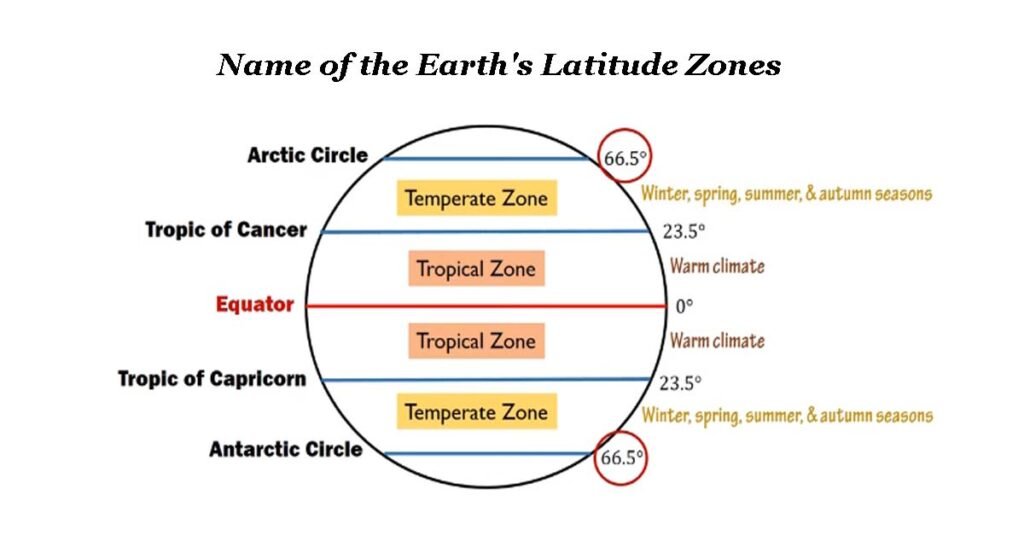Have you ever wondered why certain parts of the world are hotter or colder than others? Why do some regions experience extreme seasons while others enjoy more moderate climates? The answer lies in a key geographical factor: Latitude plays a crucial role in shaping the climate patterns we observe across the globe. In this article, In this article, Here will discuss into the fascinating relationship between and How does Latitude Affect Climate, exploring the various factors at play and the profound impacts they have on our planet.
The Earth’s Latitude Zones
Before we dive into the effects of latitude on climate, let’s first understand the Earth’s latitude zones. Latitude refers to the angular distance of a specific location from the Earth’s equator, measured in degrees. The equator itself lies at 0 degrees latitude and serves as the reference point for dividing the Earth into different zones.

- Tropical Zone (+23.5° to -23.5°): The tropical zone stretches from the Tropic of Cancer at approximately 23.5 degrees North to the Tropic of Capricorn at around 23.5 degrees South. This region experiences high temperatures, abundant rainfall, and consistent sunlight throughout the year.
- Temperate Zones (23.5° to 66.5°): The temperate zones are located between the tropical and polar zones. They span from the Tropic of Cancer to the Arctic Circle in the Northern Hemisphere and from the Tropic of Capricorn to the Antarctic Circle in the Southern Hemisphere. These regions typically have moderate temperatures and experience distinct seasons.
- Polar Zones (66.5° to 90°): The polar zones extend from the Arctic Circle in the Northern Hemisphere to the North Pole and from the Antarctic Circle in the Southern Hemisphere to the South Pole. These areas are characterized by extremely cold temperatures, long winters, and little to no sunlight during certain periods.
How does Latitude Affect Climate at Different Factors
The major factors that cause variations in climate based on latitude are the angle of sunlight, atmospheric circulation patterns, and proximity to large bodies of water. Let’s examine the importance of each of these factors:
1: Angle of Sunlight
As we move away from the equator towards the poles, the angle at which sunlight reaches the Earth’s surface changes significantly. This variation in the angle of sunlight has a profound impact on climate.
- In the tropical zone, the sun’s rays hit the Earth’s surface more directly, leading to higher temperatures and an abundance of solar energy.
- In the temperate zones, the angle at which sunlight reaches the surface becomes more oblique, resulting in milder temperatures compared to the tropics.
- In the polar zones, sunlight arrives at an extreme angle, leading to colder temperatures and shorter daylight hours, particularly during the winter months.
2: Atmospheric Circulation Patterns
The Earth’s atmospheric circulation patterns, such as the Hadley, Ferrel, and Polar cells, play a significant role in distributing heat from the equator towards the poles. These circulation cells transport warm air from the tropics and cold air from the poles, influencing climate across different latitudes.
- In the tropics, the Hadley cell creates a zone of low-pressure air, resulting in abundant rainfall and the formation of rainforests. This creates the humid and tropical climate characteristic of the region.
- In the temperate zones, the Ferrel cell facilitates the movement of air masses, leading to the development of prevailing winds and the occurrence of distinct seasons.
- In the polar regions, the Polar cell is responsible for cold air descending and creating high-pressure systems. The result is freezing temperatures, frigid winds, and the formation of polar ice caps.
3: Proximity to Large Bodies of Water
The presence of large bodies of water, such as oceans and seas, also significantly affects climate at different latitudes. Water has a high heat capacity, meaning it can absorb and retain heat more effectively than land. This influence moderates temperatures and contributes to the formation of specific climate patterns.
- Coastal regions at mid-latitudes often experience milder climates due to the moderating effect of nearby oceans. The influence of these bodies of water can reduce temperature extremes and increase precipitation.
- Inland areas at similar latitudes, far away from large bodies of water, tend to have more extreme temperature variations, with hot summers and cold winters.

Look at the above diagram to the right. Areas of the earth with low latitudes (like the EQUATOR) receive the most direct sunlight, so those latitudes are hotter. Areas with high latitudes (like near the North or South poles) receive very little direct sunlight, so those latitudes are colder.
Conclusion
Understanding the impact of latitude on climate provides us with a deeper appreciation of the complex relationship between geography and weather patterns. From the scorching tropics to the frigid polar regions, latitude plays a central role in determining the climatic conditions experienced by different parts of the world. The angle of sunlight, atmospheric circulation patterns, and proximity to large bodies of water all intertwine to create the diverse climatic mosaic we witness on our planet.
How much more is New York expensive than London?
Next time you step outside and feel the warmth of the sun or bundle up to brave the winter cold, take a moment to consider how your latitude is shaping the climate around you. Climate, like the Earth itself, is a fascinating and interconnected system that continues to both amaze and humble us.
Daniel Jack is a senior finance and insurance writer and analyst at The US Pedia. For more than 8 years, he has been helping consumers learn about the finance, insurance and banking related. Daniel enjoys translating the complexities of insurance into easy-to-understand advice and tips to help consumers make the best choices for their needs. He completed his MBA (Master of Business Administration) from the University of Chicago.









